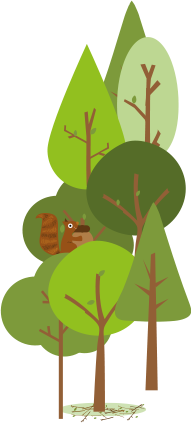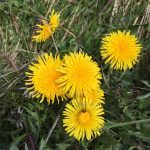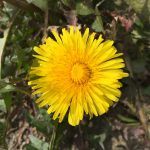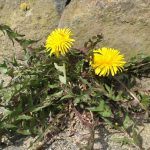

The Lost Words March: Dandelion
30th March 2020

Robert Macfarlane’s poem, ‘The Dandelion Spell’ from his book The Lost Words ends with this sentence, perfectly mirroring my own thoughts on this little plant!

‘Never would I call you only, merely, simply, a ‘weed’
(Tick-tock, sun clock, clover and dock)
The name ‘dandelion’ is thought to come from the French name ‘dents de lions’ which means lions’ teeth. Their German name, ‘lowenzahn’ also means the same thing and this is due to the tooth like jagged leaf edges resemblance to the teeth of lions. In France, however, they are known as ‘pissenlit’, which literally translates to ‘piss in bed’ thanks to the plant having powerful diuretic properties!
Dandelions can reproduce by both cross-fertilisation and apomixis, which is plant reproduction without the need to cross fertilise. This process results in clones of the parent plant – which explains how, left unchecked, they can take over a patch of land in very little time! The yellow heads of the dandelion plant are made up of tiny yellow flowers, called florets, and it is each one of these that turns into a seed attached to a tiny parachute. Once the yellow heads appear, they last only a couple of days before closing up to reopen as puffballs, providing many a game at playtime for generation after generation of children. Who remembers ‘telling the time’ by the number of blows it took to blow all the seeds off the dandelion ‘clock’?

Home-made Dandelion Wine recipe
Ingredients:
- The florets from enough complete dandelion heads to loosely fill a gallon container
- 5 litres of water
- 5kg sugar
- Zest and juice of 4 lemons
- 500g raisins, chopped or squashed by putting in a carrier bag and pounding, or 200ml of white
- grape juice concentrate
- 1 sachet of white wine yeast
- Yeast nutrient
Method:
- Boil the water and pour over the florets. Cover & leave for a couple of days, stirring occasionally
- Pour into a large saucepan then add the lemon zest
- Bring to the boil then stir in the sugar until dissolved. Continue to boil for five minutes
- Take off the heat, add the lemon juice and the crushed raisins or grape juice concentrate
- Clean your fermenting bucket thoroughly using a campden tablet, pour in the mix and cover until cool
- Add the yeast and yeast nutrient then cover
- Ferment for three or four days
- Transfer into a demijohn using a sterilised sieve and funnel. Fit a bubble trap and allow to ferment for a couple of months, then strain through muslin several times into a fresh container, leave until clear then bottle and enjoy!
By Lauren Emsley
Robert Macfarlane Twitter: @RobGMacfarlane

